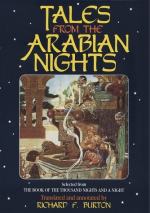[FN#82] Arab. “Liwan al-barrani,” lit.=the outer bench in the “Maslahk” or apodyterium.
[FN#83] Arab. “Ma’jun,” pop. applied to an electuary of Bhang (Cannabis sativa): it is the “Maagoon” sold by the “Maagungee” of Lane (M.E. chapt. xv.). Here, however, the term may be used in the sense of “confections” generally, the sweetmeats eaten by way of restoratives in the Bath.
[FN#84] He speaks of taking her maidenhead as if it were porter’s work and so defloration was regarded by many ancient peoples. The old Nilotes incised the hymen before congress; the Phoenicians, according to Saint Athanasius, made a slave of the husband’s abate it. The American Chibchas and Caribs looked upon virginity as a reproach, proving that the maiden had never inspired love. For these and other examples see p. 72, chap. iii. “L’Amour dans l’Humanite,” by P. Mantegazza, a civilised and unprejudiced traveller.
[FN#85] Arab. “Zill,” lit. “shadow me.”
[FN#86] Arab. “Istinshak,” one of the items of the “Wuzu” or lesser ablution: see vol. v. 198.
[FN#87] In Chavis her name is “Zaliza” and she had “conceived an unhappy passion” for her master, to whom she “declared her sentiments without reserve.”
[FN#88] Arab. “Armaghanat,” the Arab. plur. of “Armaghan,” Pers.=a present.
[FN#89] In the text, “jumlatun min al-mal,” which Scott apparently reads “Hamlat al-jamal” and translates (p. 38) “a camel’s load of treasure.”
[FN#90] The learned man was to exorcise some possible “evil spirit” or “the eye,” a superstition which seems to have begun, like all others, with the ancient Egyptians.
[FN#91] The Ms., I have said, always writes “Khwaja” instead of “Khwajah” (plur. “Khwajat"): for this word, the modern Egyptian “Howajah,” see vol. vi. 46. Here it corresponds with our “goodman.”
[FN#92] Arab. “Yatazawadu"=increasing.
[FN#93] By which she accepted the offer.
[FN#94] This incident has already occurred in the tale of the Portress (Second Lady of Baghdad, vol. i. 179), but here the consequences are not so tragical. In Chavis the vulgar cock becomes “a golden Censer ornamented with diamonds, to be sold for two thousand sequins” (each=9 shill.).
[FN#95] A royal sign of wrath generally denoting torture and death. See vols. iv. 72; vi. 250.
[FN#96] Arab. “Ya Sallam,” addressed to Allah.
[FN#97] Here more is meant than meets the eye. When a Moslem’s head was struck off, in the days of the Caliphate, it was placed under his armpit, whereas that of a Jew or a Christian was set between his legs, close to the seat of dishonour.
[FN#98] In Chavis and Cazotte the lady calls to “Morigen, her first eunuch, and says, Cut off his head!” Then she takes a theorbo and “composed the following couplets”—of which the first may suffice:
Since
my swain unfaithful proves,
Let
him go to her he loves, etc., etc.




